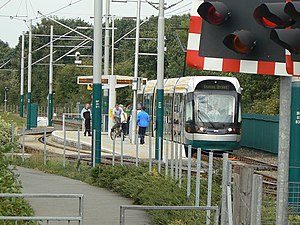Bulwell Forest | |||||||||||
|---|---|---|---|---|---|---|---|---|---|---|---|
| Nottingham Express Transit tram stop | |||||||||||
 | |||||||||||
| General information | |||||||||||
| Location | Bulwell, City of Nottingham England | ||||||||||
| Coordinates | 53°00′21″N 1°11′25″W / 53.005876°N 1.190277°W | ||||||||||
| Owned by | Nottingham Express Transit | ||||||||||
| Operated by | Nottingham Express Transit | ||||||||||
| Line(s) | 1 | ||||||||||
| Platforms | 1 | ||||||||||
| Tracks | 1 | ||||||||||
| Construction | |||||||||||
| Structure type | At grade; on private right of way | ||||||||||
| Accessible | Step-free access to platform | ||||||||||
| Key dates | |||||||||||
| 9 March 2004 | Opened | ||||||||||
| Services | |||||||||||
| |||||||||||
| |||||||||||
Bulwell Forest is a tram stop on the Nottingham Express Transit (NET) light rail system in the city of Nottingham in the suburb of Bulwell. It is part of the NET's initial system, and is situated on the long single line section between Bulwell and Hucknall tram stops that runs alongside the Robin Hood railway line. Like all the other intermediate stops on this section, the stop has a passing loop with an island platform situated between the two tracks of the loop.[1][2]
With the opening of NET's phase two, Bulwell Forest is now on NET line 1, which runs from Hucknall through the city centre to Beeston and Chilwell. Trams run at frequencies that vary between 4 and 8 trams per hour, depending on the day and time of day.[3][4]
The tram stop should not be confused with the former Bulwell Forest railway station, which was situated on the, now closed, Great Northern Railway's Nottingham to Shirebrook line, some 750 metres (2,460 ft) to the south-east of the tram stop. The Robin Hood line that passes alongside the stop was originally the former Midland Railway route from Nottingham to Worksop, but there has never been a railway station at the stop's location.[5]
There is a road level crossing just to the south of the tram stop, and pedestrian access to the stop is from this crossing. At the crossing, both tram and railway lines are protected by the automatic barriers. #
- ^ "Nottingham Express Transit : Tram Stops : Bulwell Forest". TheTrams.co.uk. Archived from the original on 26 August 2015. Retrieved 9 August 2015.
- ^ Election Maps (Map). Ordnance Survey. Retrieved 14 August 2015. Viewed for appropriate area with unitary authority ward boundaries and names selected.
- ^ "Extending your Tram Service" (PDF). Nottingham Express Transit. Archived (PDF) from the original on 7 August 2015. Retrieved 5 August 2015.
- ^ "Nottingham Express Transit Phase 2 opens". Railway Gazette. DVV Media UK Ltd. 25 August 2015. Archived from the original on 28 August 2015. Retrieved 25 August 2015.
- ^ "Rail Map Online". RailMapOnline.com. Retrieved 14 August 2015. Viewed for appropriate area with stations and station labels active.
